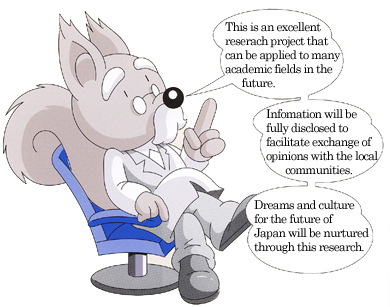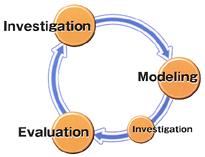| Research and investigation to understand deep geological
environments and practical application of geological disposal
technology will be carried out. |
 Research
and geological disposal of high-level radioactive waste conducted at the Horonobe
Underground Research Center covers various fields of geoscience and contributes
to a wide range of academic pursuits. No radioactive waste will be brought in
nor used in the research area during or even after research. Underground research
facilities will not be transferred nor rented to the implementation body of final
disposal. The facilities will be closed and be backfilled upon completion of research.
The research area will not be a final disposal site of radioactive waste nor will
an interim storage facility for radioactive waste be constructed in Horonobe in
the future. Research
and geological disposal of high-level radioactive waste conducted at the Horonobe
Underground Research Center covers various fields of geoscience and contributes
to a wide range of academic pursuits. No radioactive waste will be brought in
nor used in the research area during or even after research. Underground research
facilities will not be transferred nor rented to the implementation body of final
disposal. The facilities will be closed and be backfilled upon completion of research.
The research area will not be a final disposal site of radioactive waste nor will
an interim storage facility for radioactive waste be constructed in Horonobe in
the future. |
Research themes
Geoscientific
research
This is to understand the present condition of geological
environment, its basic mechanism, and to predict changes
in the future. Through research on the properties of groundwater
and bedrock, technology can be further developed for a
better understanding of deep geological environments and
to pave the way for future research.
Research
and development on geological disposal
The feasibility fo the design and construction of a disposal system is being confirmed
in an actual deep geological environment. Research is also being conducted for
improving the reliability of safety assessment technology.
|
Research and investigation
schedule
The 20-year research and investigation period can be divided
into three phases; (1) from the surface; (2) during shaft
and drift excavation (construction of underground facilities);
(3) in the underground facility.
>>Research
schedule
The basic
steps of research, modeling and evaluation , are
repeated to improve the research and analysis methods.  |
 |
Geophysical investigations
from the air and ground surface, and borehole investigations
are conducted. Deep geological environments are
modeled based on the data.
|
 |
Models made through surface-based investigations
are evaluated during excavation of shafts and drifts. The effects of shaft excavation
are also studied.
|
 |
| Detailed geophysical
and borehole investigations are conducted in the
shafts and drifts to study long-term changes in
rock properties, groundwater flow and chemistry.
Detailed in-situ experiments are also carried out.
Technology concerning design and construction of
disposal system and shaft sealing technology are
also developed. |
|
